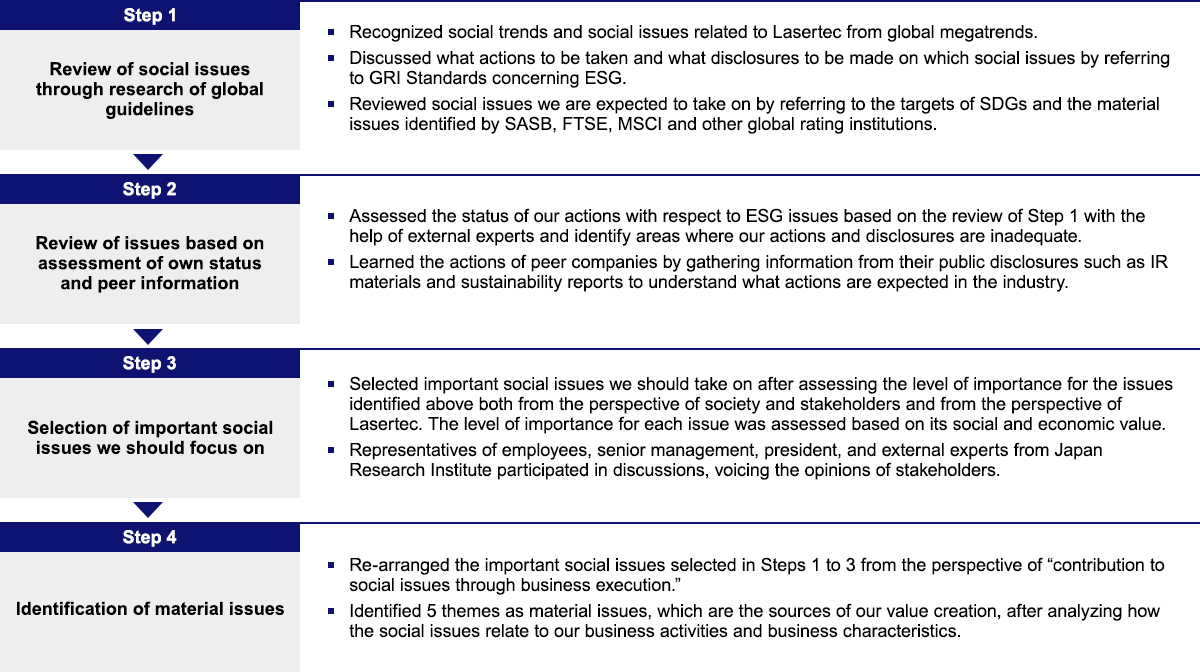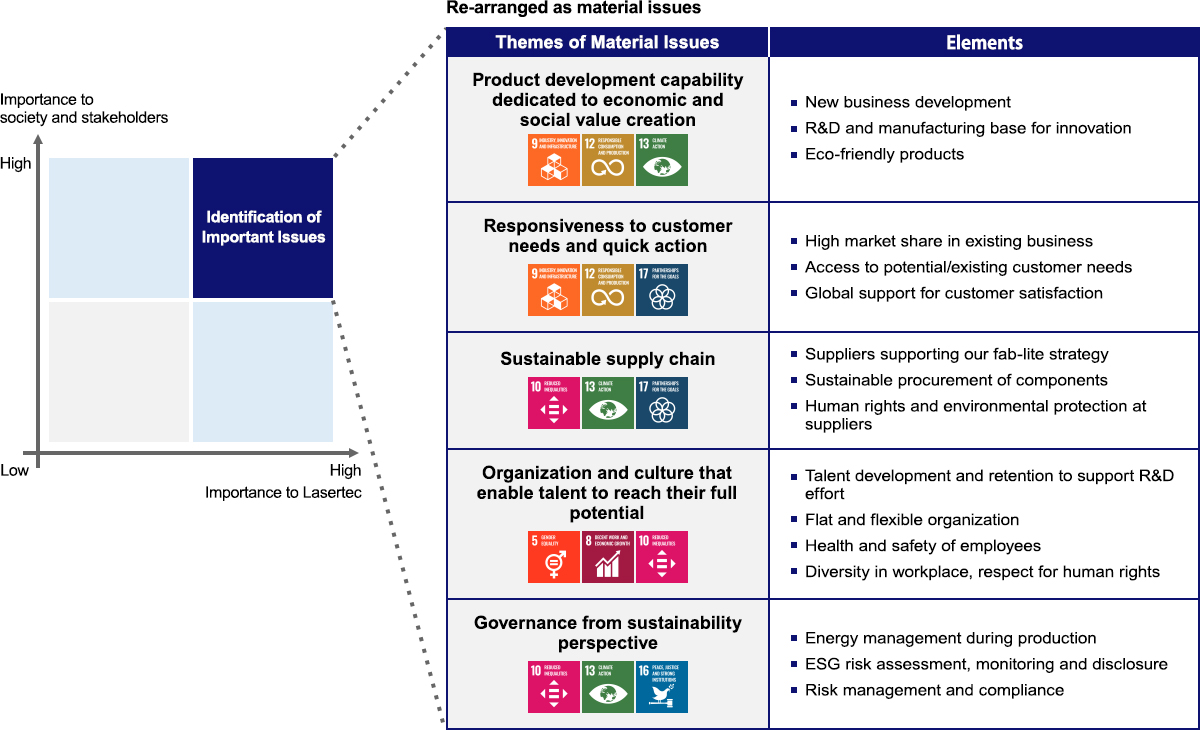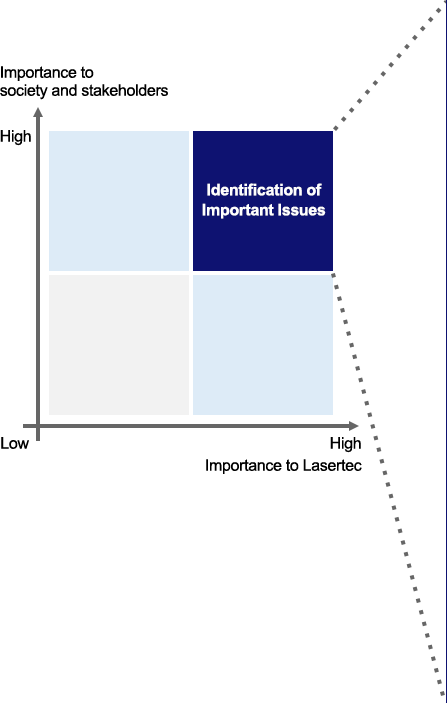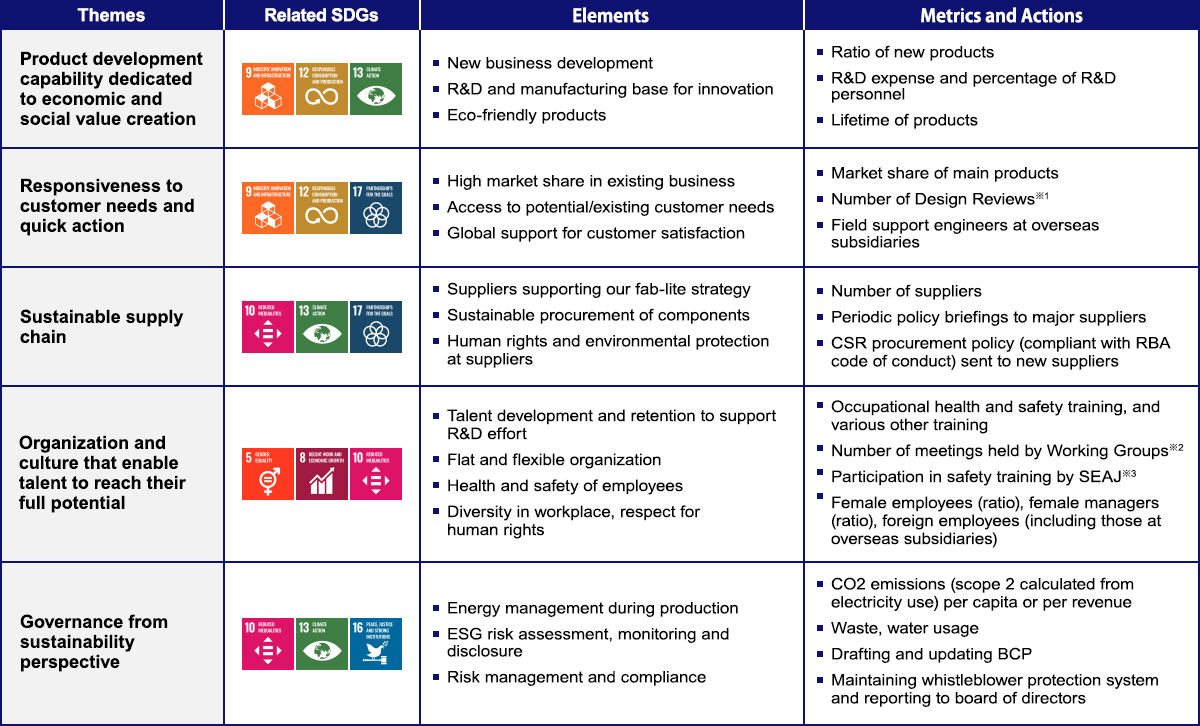Material Issues
Process of materiality assessment
We took the following 4 steps to identify material issues for us among various social issues. We assessed the materiality of issues in light of the responsibility to meet the expectation of society and the effort to increase corporate value in the mid- to long-term.

-
Step 1Review of social issues
through research of global
guidelines- Recognized social trends and social issues related to Lasertec from global megatrends.
- Discussed what actions to be taken and what disclosures to be made on which social issues by referring to GRI Standards concerning ESG.
- Reviewed social issues we are expected to take on by referring to the targets of SDGs and the material issues identified by SASB, FTSE, MSCI and other global rating institutions.
-
Step 2Review of issues based on
assessment of own status
and peer information- Assessed the status of our actions with respect to ESG issues based on the review of Step 1 with the help of external experts and identify areas where our actions and disclosures are inadequate.
- Learned the actions of peer companies by gathering information from their public disclosures such as IR materials and sustainability reports to understand what actions are expected in the industry.
-
Step 3Selection of important social
issues we should focus on- Selected important social issues we should take on after assessing the level of importance for the issues identified above both from the perspective of society and stakeholders and from the perspective of Lasertec. The level of importance for each issue was assessed based on its social and economic value.
- Representatives of employees, senior management, president, and external experts from Japan Research Institute participated in discussions, voicing the opinions of stakeholders.
-
Step 4Identification of material issues
- Re-arranged the important social issues selected in Steps 1 to 3 from the perspective of "contribution to social issues through business execution."
- Identified 5 themes as material issues, which are the sources of our value creation, after analyzing how the social issues relate to our business activities and business characteristics.
Material issues identified
In the steps described above, we identified the following material issues:
- 1Product development capability dedicated to economic and social value creation
- 2Responsiveness to customer needs and quick action
- 3Sustainable supply chain
- 4Organization and culture that enable talent to reach their full potential
- 5Governance from sustainability perspective


| Themes of Material Issues | Elements |
|---|---|
|
Product development capability
dedicated to economic and social value creation |
|
|
Responsiveness to customer
needs and quick action |
|
|
Sustainable supply chain
|
|
|
Organization and culture that
enable talent to reach their full potential |
|
|
Governance from sustainability
perspective |
|
1. Product development capability dedicated to economic and social value creation
Product development capability is at the heart of our value creation. It is a matter of paramount importance that we keep engaging in new business development and, for this purpose, establish, maintain and nurture an adequate product development/production infrastructure that enables us to make innovations. We also recognize that it is highly important to make eco-friendly products in order to practice our "contribution to social issues through business execution."
- Related metrics and actions
-
- Ratio of new products
- R&D expense and percentage of R&D personnel
- Lifetime of products
2. Responsiveness to customer needs and quick action
To practice social contribution through product development, it is important that we respond to market needs quickly and launch perfectly fit products in a timely manner. In this respect, it is crucial that we keep addressing customer's challenges in the existing business while striving to gain access to new customer needs at the earliest time. Since the majority of our customers are located globally, we must establish, maintain and nurture a global support infrastructure that ensures smooth operation of products for them.
- Related metrics and actions
-
- Market share of main products
- Number of Design Reviews*1
- Field support engineers at overseas subsidiaries
- *1A Design Review is a meeting to review product designs, but we also discuss technical solutions to customer needs and applications based on the information collected in the field. The frequency of this meeting is a good indication of our responsiveness, or whether we are providing solutions promptly.
3. Sustainable supply chain
We have adopted a so-called "fab-lite" strategy where the use of our own resources is concentrated on R&D while the production is outsourced to subcontractors. For this strategy to work, we must forge a good partnership with highly skilled manufacturing experts and suppliers well versed in the area of technology we pursue. We also recognize that it is important to exercise the sustainable procurement of production materials, keep us informed of the status of human rights and environmental actions in the supply chain and, if necessary, make improvements.
- Related metrics and actions
-
- Number of suppliers
- Periodic policy briefings to major suppliers
- CSR procurement policy (compliant with RBA code of conduct) sent to new suppliers
4. Organization and culture that enable talent to reach their full potential
It is extremely important for us to hire and nurture technical talent who can engage in product development so that we can maintain our product development capability. It is equally important for us to have a flat and flexible organization and a free-spirited culture, which together allow us to make a quick decision and action to bring solutions to customers promptly. To maintain a healthy and safe workplace is one of the most important issues for us because the company's growth is driven by the dedicated effort of employees. Throughout our global operation, we are actively hiring and promoting local talent well versed in the local business practices so that we can be successful in each of the regions we operate in. We also recognize the need to actively promote diversity in the workplace and ensure respect for human rights.
- Related metrics and actions
-
- Occupational health and safety training, and various other training
- Number of meetings held by Working Groups*2
- Participation in safety training by SEAJ*3
- Female employees (ratio), female managers (ratio), foreign employees (including those at overseas subsidiaries)
- *2At each Working Group, engineers with the same functional responsibility (software, optics, mechanics, electronics, etc.) get together to share their knowledge and experience, even though they belong to various technology departments making different products.
- *3Semiconductor Equipment Association of Japan
5. Governance from sustainability perspective
We will put a system in place to manage energy consumption during our production process to help mitigate global warming and other environmental issues. We will identify potential ESG risks, monitor them and make disclosures as much as possible. We recognize that it is important to maintain a system of governance based on risk management and compliance and keep making improvements so that we can achieve growth and contribute to the sustainable growth of society.
- Related metrics and actions
-
- CO2 emissions (scope 2 calculated from electricity use) per capita or per revenue
- Waste, water usage
- Drafting and updating BCP
- Maintaining whistleblower protection system and reporting to board of directors

| Themes | Related SDGs | Elements | Metrics and Actions |
|---|---|---|---|
|
Product development
capability dedicated to economic and social value creation |
|
|
|
|
Responsiveness to
customer needs and quick action |
|
|
|
|
Sustainable supply
chain |
|
|
|
|
Organization and
culture that enable talent to reach their full potential |
|
|
|
|
Governance from
sustainability perspective |
|
|
|
- *1A Design Review is a meeting to review product designs, but we also discuss technical solutions to customer needs and applications based on the information collected in the field. The frequency of this meeting is a good indication of our responsiveness, or whether we are providing solutions promptly.
- *2At each Working Group, engineers with the same functional responsibility (software, optics, mechanics, electronics, etc.) get together to share their knowledge and experience, even though they belong to various technology departments making different products.
- *3Semiconductor Equipment Association of Japan
We will review the metrics and actions related to the material issues periodically and make disclosures about our goals and results as well as about the achievements we have made through our actions.








